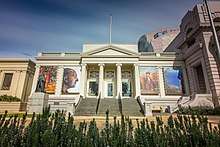Geelong Art Gallery
 Geelong Gallery from Johnstone Park | |
| Former name | Geelong Art Gallery |
|---|---|
| Established | 1895 |
| Location | 55 Little Malop St, Geelong, Australia |
| Type | Art gallery |
| Director | Jason Smith |
| Curator | Lisa Sullivan |
| Website | http://www.geelonggallery.org.au |
The Geelong Art Gallery, currently known as Geelong Gallery, is a major regional gallery in the city of Geelong in Victoria, Australia. The gallery has approximately 4,000 works of art in its collection. The gallery forms Geelong's Arts Precinct with the adjacent Geelong Performing Arts Centre, Geelong Heritage Centre, Geelong Courthouse centre, and the Geelong Library.
History
An art gallery for Geelong was first petitioned for in 1895 by members of the Geelong Progress League. In May 1900 permission was given for the Geelong Art Gallery Association to use three walls in the Geelong Town Hall to hang artwork on. Among the first acquisitions made was Frederick McCubbin's 1890 A bush burial which cost 100 guineas ($210 USD) at the time. The gallery was soon moved to the Free Library Building in Moorabool Street (between Malop and Corio Streets).
On 31 May 1900, the formal opening of the Geelong Art Gallery took place at the town hall. Mr. S. Austin, M.L.C., presided and the mayor Alderman Carr made a speech officially declaring it open to the public.
In March 1903, two watercolour drawings of colonial life in Victoria were presented to the Geelong Art Gallery by Mr. G.M. Hitchcock. One depicts William Buckley 'the wild white man'. The other drawing is of the interior of the first newspaper office in Melbourne.
Building
The current Geelong Gallery was officially opened in 1915, and was erected as a memorial to the late George M. Hitchcock. It is located on the south side of Johnstone Park, between the Town Hall and the former fire station site, now occupied by the Geelong Library and Heritage Centre. The initial building consisted of a portico and vestibule facing the park, and the G. M. Hitchcock Gallery.
The first additions to the gallery occurred in 1928 when the Henry P. Douglas Gallery was opened, followed by the H.F. Richardson Gallery in 1937. The main entrance to the gallery was moved to Little Malop Street with the opening of the J.H. McPhillimy Gallery by then-Prime Minister Joseph Lyons in 1938. Further expansion followed in 1956 and 1971.
Collection
The Gallery has a collection of over 6,000 Australian and International items including works on paper, paintings, decorative arts and sculpture.[1] Individual collection items can be viewed on the Geelong Gallery collection website.
There are a number of notable artworks in the collection:
- View of Geelong (1856), by Eugene von Guerard
- A bush burial (1890), by Frederick McCubbin
- The pier head (1910), by Stanhope Forbes, considered "one of the greatest British impressionist paintings in Australia"[2]
References
- ↑ "Collection | Geelong Gallery". www.geelonggallery.org.au. Retrieved 2018-05-18.
- ↑ Bronwyn Watson, "public works", Weekend Australian, 23–24 January 2016, Review, p. 10
- Beg, Peter. (1990). Geelong - The First 150 Years. Globe Press. ISBN
0-9592863-5-7
- Geelong Gallery: About the Gallery.
External links
| Wikimedia Commons has media related to Geelong Art Gallery. |
Coordinates: 38°08′50.42″S 144°21′26.60″E / 38.1473389°S 144.3573889°E